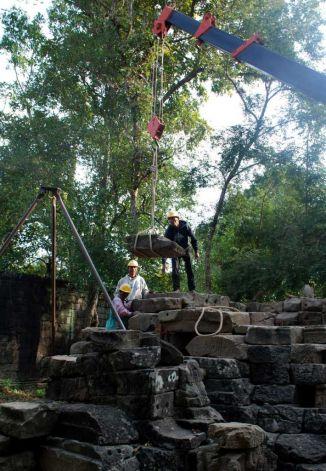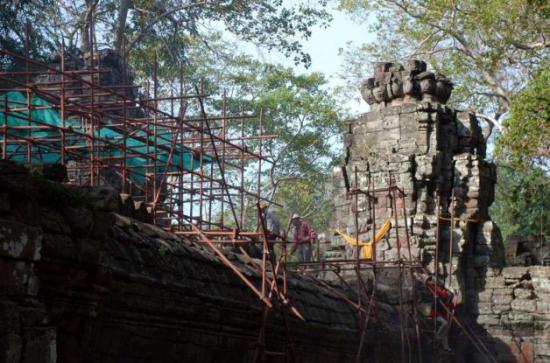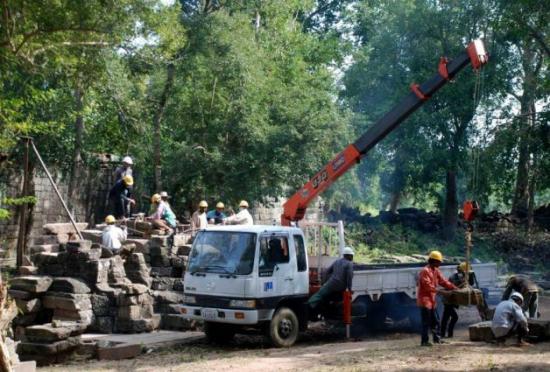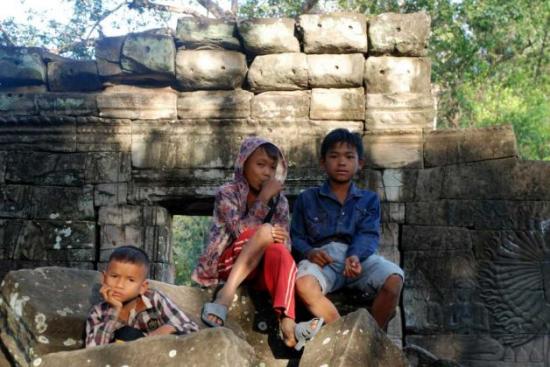Cambodia's "second Angkor" stirs to life
Denis D. Gray / Associated Press
Source - http://www.seattlepi.com/news/article/Cambodia-s-second-Angkor-stirs-to-life-2438574.php#ixzz1ibVvIqI9

Using a crane, workers move heavy sandstone blocs from a tower within the Buddhist temple of Banteay Chhmar, Cambodia. It's still entwined in mystery and jungle vines, but one of Cambodia's grandest monuments is slowly awakening after eight centuries of isolated slumber, having attracted a crack archaeological team and a trickle of tourists. Photo: Denis Gray / AP
It's still entwined in mystery and jungle vines, but one of Cambodia's grandest monuments is slowly awakening after eight centuries of isolated slumber, having attracted a crack archaeological team and a trickle of tourists.
"It takes awhile to unfold this temple — and everywhere there are enticements," says John Sanday, the team leader, as he navigates through tangled undergrowth, past dramatic towers and bas-reliefs and into dark chambers of the haunting monastic complex of Banteay Chhmar.
What drove Jayavarman VII, regarded as the greatest king of the Angkorian Empire, to erect this vast Buddhist temple about 105 miles (170 kilometers) from his capital in Angkor and in one of the most desolate and driest places in Cambodia remains one of its many unsolved riddles.
At its height in the 12th century, the empire extended over much of Southeast Asia, its rulers engaging in a building frenzy which produced some of the world's greatest religious monuments.
Called the "second Angkor Wat," Banteay Chhmar approaches it in size, is more frozen in time than the manicured and made-over superstar, and has so far been spared the blights of mass tourism of recent years at Angkor.

Restoration work continues around one of 34 towers at the Buddhist monastery of Banteay Chhmar in northwestern Cambodia. It's still entwined in mystery and jungle vines, but one of Cambodia's grandest monuments is slowly awakening after eight centuries of isolated slumber, having attracted a crack archaeological team and a trickle of tourists. Photo: Denis Gray / AP
In 2011, an average of 7,000 tourists a day visited Angkor, one of Asia's top tourist draws located near the booming northwestern city of Siem Reap. Banteay Chhmar saw an average of two a day, with no tour buses and bullhorn-wielding guides to disturb the temple's tranquility or traditional life in the surrounding village.

Workers use a crane to move sandstone blocs as they restore one of the damaged towers at the 800-year-old Buddhist temple of Banteay Chhmar in northwestern Cambodia. A team from the US-based Global Heritage Fund and the Cambodian government is reviving one of the masterpieces of the Angkorian Empire. Photo: Denis Gray / AP
Abandoned for centuries, then cut off from the world by the murderous Khmer Rouge and a civil war, Banteay Chhmar didn't welcome visitors until 2007, when the last mines were cleared and the looting that plagued the defenseless temple in the 1990s was largely halted.
A year later, the California-based Global Heritage Fund began work at the site under the overall control of the country's Ministry of Culture and now spends about $200,000 a year on the project.
Sanday, a veteran British conservation architect, assembled a team of 60 experts and workers, some of whom were with him on an earlier restoration of the Preah Khan temple at Angkor. Others were recruited from the surrounding community and although barely literate, Sanday says they're among the best he's worked with in Asia.
Challenging them are hundreds of thousands of stone blocks from collapsed shrines and galleries scattered helter-skelter within the 4.6-square-mile (12-square-kilometer) archaeological site. Towers teeter, massive tree roots burrow into walls, vegetation chokes a wide moat girding the temple.

Cambodian children from a nearby village sit amid the ruins of Banteay Chhmar, a vast, remote temple built around 1200. It's still entwined in mystery and jungle vines, but one of Cambodia's grandest monuments is slowly awakening after eight centuries of isolated slumber, having attracted a crack archaeological team and a trickle of tourists. Photo: Denis Gray / AP
Three-quarters of the bas reliefs — rarely found at other Angkorian temples — have fallen or been looted, the most notable being eight panels depicting Avalokiteshvara, an enlightened being embodying Buddhist compassion.
Thieves sheared off four panels with jackhammers, smuggling them into nearby Thailand where two are widely believed to be decorating the garden of a Thai politician. A pair has been recovered and the others are still at the temple, although only two still stand.
"We've been struggling away with this gallery for nearly two years now," says Sanday at another bas-relief, one depicting a figure believed to be Jayavarman VII leading his troops into battle. In vivid detail, the ancient sandstone wall springs to life with charging war elephants, soldiers plunging spears into their enemies and crocodiles gobbling up the dead.
PART. 2